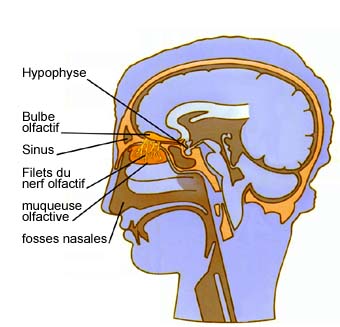Considerable progress in understanding the workings of the sense of smell has been made over the last thirty years. Even a sketchy understanding of the mechanisms involved can help us imagine what we can expect when tasting a cigar.
An airborne odour molecule comes into contact with the nasal mucosa. The mucosa are covered in a film of liquid covering the olfactory receptors. The molecule penetrates the liquid to be perceived by the olfactory nerves; odour molecules must therefore be soluble. Because insoluble substances cannot reach the nasal mucosa they are odourless. Then, due to the continuous movement to which all liquids are subject, the molecule comes into contact with a nerve ending. The neurone fibril may carry a protein, i.e. a macromolecule with which the odour molecule may have a chemical affinity. Contact is established and the electrical status of the neurone is modified at this exact point. This sudden difference in electrical potential makes the surface of the neurone permeable to the ions present, enabling them to penetrate the neurone by osmosis. The sudden presence of these ions causes a sudden change in potential and triggering an electrical current that travels along the axis of the neurone. An infinitesimal electrical contact is thus greatly amplified before being transmitted.
The human body has nearly 25 million neurones that are sensitive to a large number of bodies. They are continuously sending amplified data to the olfactory lobes of the brain where the data is sorted and compared. The latest research has found that the surface of the fibrils of the branches or dendrites of each neurone carry a protein capable of adsorbing certain odour molecules, i.e. establishing contact with them which, though fleeting, is enough to cause transmission of data to the olfactory lobes. The brain sorts all the data it receives, probably using a system rather like a card index. The "pattern" of the smell is compared with the patterns stored in the memory to identify the odour detected by analogy. The mechanism is of infinite complexity and the brain tries to establish an olfactory acuity that is as accurate as possible. For example, you detect a smell of bananas but feel there is something else present. As you continue sniffing the first sensation weakens to give way to an underlying smell: strawberry. You continue sniffing and the strawberry smell dies away in its turn. You now detect a sweetish odour that is definite though unidentified. The brain gets to work; memory comes into play through an association of images: a hot afternoon... a pavement cafZ... cool shade... an impression of damp... The entire scene returns to consciousness. The memory you were seeking finally breaks free from the mass of details: the first time you ate a mango.

The first sensation you get from a cigar is one of olfactory intensity. This is known as its "body" and relates both to olfactory factors and nicotine. In everyday language, people describe a cigar as strong or mild. But these terms are ambiguous. Just like the effects produced by a perfume, the olfactory stimulations produced by tobacco smoke have an aesthetic resonance. And also like perfume, tobacco smoke is a complex mixture of odours, some of which are fleeting, others heavy and vague. Changes occur as the taste persists until there is nothing left but the most persistent component of the initial impression. But cigar smoke also contains nicotine which reaches the brain via the bloodstream, where it causes major, complex but fleeting changes. Although the correlation between the level of nicotine the smoke from a cigar contains and the dense olfactory constituents that give the smoke its characteristic taste and appearance is far from strict, they are nevertheless closely linked. In scientific terms, all the ingredients, including nicotine, form the semi-liquid phase of the smoke; they are present in the form of tiny droplets suspended in a gas, i.e. what is technically known as an aerosol. This explains why the impression of olfactory intensity is always linked to the level of nicotine absorbed and its effects. The final stage is one of satisfaction. This feeling is similar to the feeling of having eaten one's fill. In the case of a cigar, the smoker is satisfied so stops smoking. Olfactory intensity or "body" is thus an evaluation of the quantity both of olfactory constituents and nicotine in the smoke. This is why very intense smoke is often described as "satisfying". The stage of satisfaction is reached before more than two-thirds of the cigar has been smoked. (Incidentally, this is the usual proportion of a cigar consumed by the average smoker). "Full-bodied", "intense", "full", "substantial" and "filling" are all terms used to describe olfactory intensity. But just as a dish may be filling but tasteless, cigar smoke may well be intense but of an unrelieved dullness and poverty; it may, on the other hand, be complex, rich, even sumptuous. Olfactory richness, i.e. the variety and quality of the odours contained in the smoke, is thus the second essential characteristic of a cigar and is used to judge the complexity and variety of olfactory sensations in the smoke.
Extract from the reference book: © "CIGAR. From initiation to mastery" by Gilbert Belaubre. Photo © Fainsilbert
